
The Microcosmic Orbit
Below is a brief exploration of the Microcosmic Orbit, also known as the Small Heavenly Orbit. We will touch on its significance, history, key features, as well as different types of Microcosmic orbits and associated practices, and how it is used in different modes of practice (i.e. qigong/neigong vs dandao/neidan). This is not meant to be exhaustive and only briefly touches on some key points with a few instances of specific examples. The video form of this post can be found at the bottom of the page.
The Microcosmic Orbit is the flow of Qi around the loop created by the Ren and Du meridians, but what is the significance of this in the internal arts?
Microcosmic-macrocosmic Correspondence
The Xiao Zhoutian 小周天, which can be translated as Microcosmic Orbit, Small Heavenly Orbit, or Small Celestial Cycle, is an expression of microcosmic-macrocosmic correspondence. “As above so below”… an ancient idea permeating cultures in both the East and the West.
We know that patterns and shapes can be found in strikingly disparate contexts throughout nature. The Golden Spiral can be seen in both the cochlea in our ears as well as the shape of a spiral galaxy. The fractal geometry of our veins is also seen in the veins of a leaf as well as the branching structure of river systems and lightning bolts. It has even been uncovered that the neuronal network in the human brain resembles the cosmic network of galaxies in the Universe – and not just in the comparison of imagery – researchers have performed an in-depth analysis!
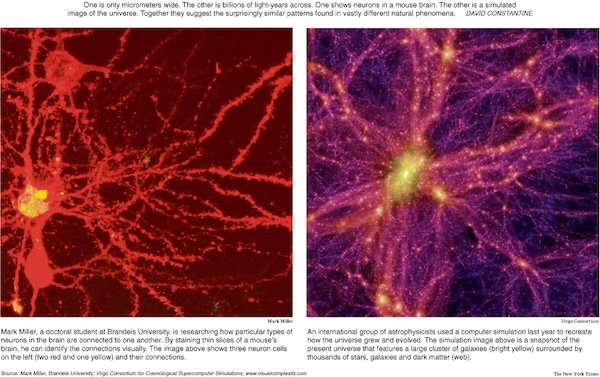
These correspondences have been a fundamental feature of Chinese thought for a very long time. Daoists view the human body as a microcosmic universe within the greater macrocosmic universe. The cycles found in nature have their corresponding cycles in the body. From our perspective on Earth, we see the sun trace an orbit overhead from horizon to horizon. This orbit, the daily cycle between night and day, relating the sun to the earth, corresponds to the movement of Qi around the microcosmic orbit in the human body.
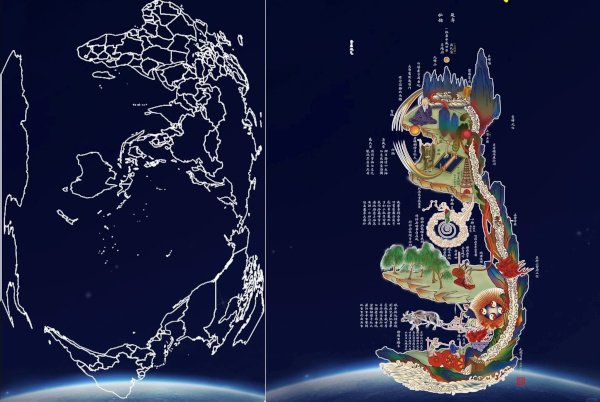
Midnight, is the most yin time in the daily cycle and corresponds to the hui yin point found at the base of the torso in the perineum, the lowest point in the body when sitting cross-legged. The progression from midnight to the most yang time of day, noon, corresponds to the passage of Qi up the Du meridian along the spine to the bai hui point on the top of the head. The descent down the front of the body through the Ren meridian corresponds to the progression from noon to midnight.
In ancient China the day was divided into 12 two-hour periods with midnight corresponding to Zi–when yin qi reaches its extreme and yang qi begins to move, and noon corresponding to Wu–when yang qi reaches its extreme and yin qi begins to sprout, so another name for the microcosmic orbit is the ziwu zhoutian (子午周天).
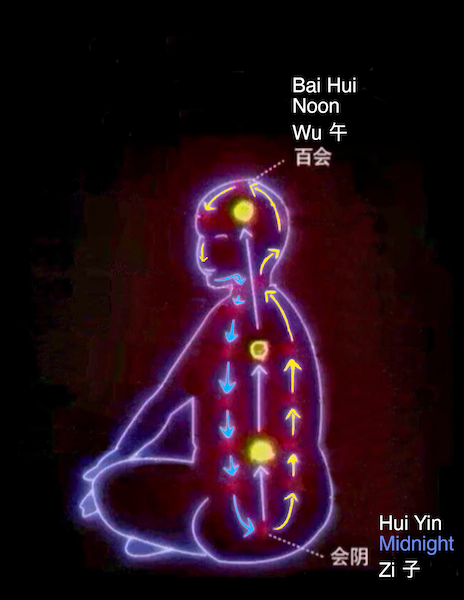
Origin of the Name
The name xiao zhoutian (microcosmic orbit or small heavenly orbit) came from the Wu Liu tradition of inner alchemy pioneered by Wu Shouyang and Liu Huayang.

However, the idea goes back much further in history where it was known by other names such as the River Wheel 河车. We find discussion of the River Wheel in earlier neidan texts such as the Ling Bao Bi Fa and the Zhong Lu Chuan Dao Ji which records a dialogue between Lu Dongbin and Zhongli Quan.
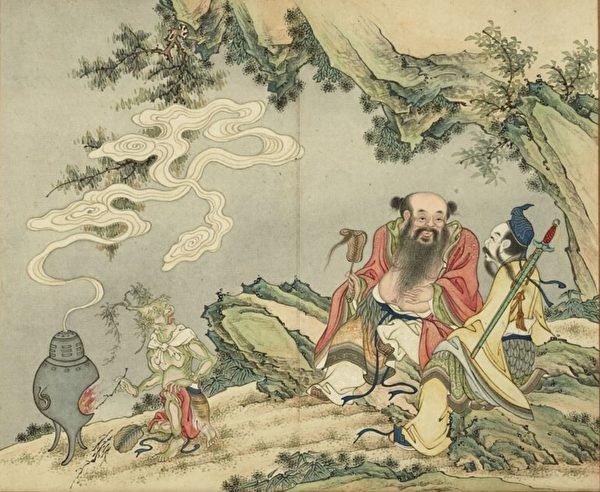
Different Types of Microcosmic Orbit
There are a number of different types of Microcosmic Orbit which can generally be distinguished by the type of Qi that is flowing through the orbit. There are also many styles of Microcosmic Orbit practice. On one end of the spectrum, there are styles of Microcosmic Orbit practice that are very physical, working to open the spine physically or apply the type of force used in hard qigong–these practices are often associated with qigong, neigong, internal martial arts or perhaps as foundation for neidan/dandao. Towards the other end of the spectrum the practices involve less and less physical movement and intention and tend to work with more refined forms of Qi. The type of orbit that results spontaneously from a state of wuwei is generally considered the highest-level and most desirable form, and is usually associated with dandao practice.
Three Barriers
Also important are the three barriers (san guān 三关) along the route of the orbit which are areas that must be opened or passed to allow the orbit to fully open. The three are identified as the Barrier of the Caudal Funnel (wei lu guan 尾闾关) the Barrier of the Spinal Handle (jiazi guan夹脊关) and the Barrier of the Jade Pillow (yuzhen guan 玉枕关) and are along the Du meridian.
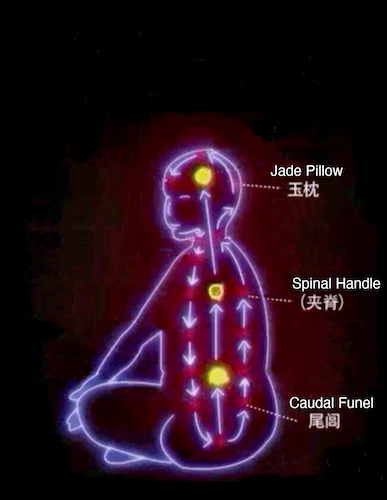
The Microcosmic Orbit can generally be classified into three types:
- Intention-driven Cosmic Orbit (yinian zhoutian 意念周天 or yixing zhoutian 意行周天)
- Meridian Cosmic Orbit (jingluo zhoutian 经络周天)
- Dandao Cosmic Orbit (dandao zhoutian 丹道周天)
The first two are generally associated with neigong or qigong whereas the last one, as the name suggests is associated with dandao practice which is also known as neidan practice.
Intention-driven Cosmic Orbit
The first type, yinian zhoutian or Intention-driven Cosmic Orbit, is only using awareness and intention to circulate around the orbit. It is essentially just imagination-based and generally is considered fairly useless at best, or even dangerous at worst, with the potential to cause Qi deviations. This is sometimes referred to as “cooking with an empty pot” since there is not yet a substance–the Qi–to run through the orbit.
Meridian Cosmic Orbit
The Meridian Cosmic Orbit is possible when a practitioner has Qi that can run through the orbit. This may be achieved either through the use of intentional practices, or spontaneously. This type of microcosmic orbit is often used in neigong systems where the intentional circulation of post-heaven Qi through the orbit is used in limited amounts to help further open the orbit and increase the flow of Qi. These practices are typically not taught to beginners to avoid the dangers of “cooking with an empty pot” as described above.
Some lineages may distinguish different types of Meridian Cosmic Orbit. For example, the Meridian Cosmic Orbit may flow over a wider area, or it can be distinguished from what might be termed the Channel Cosmic Orbit (mailuo zhoutian 脉络周天) that is a thin line.
The effects of opening the Meridian Cosmic Orbit are in line with the general benefits of neigong/qigong practice, which are to create an optimal energetic state in the body with ample jing and qi and smoothly flowing energy meridians. This can result in an optimally performing body, robust health, and longevity. The Du meridian is called the “Sea of Yang” and the Ren meridian the “Sea of Yin”, and so enhancing these has a positive effect on all of the body’s meridians.
Dandao Cosmic Orbit
The Dandao Cosmic Orbit is the type of microcosmic orbit that results from internal alchemy (dandao/neidan) practice. Here, pre-heaven Qi circulates through the orbit, which is something that becomes possible in this mode of practice that typically involves meditative practices utilizing deep stillness and stability, where the practitioner is able to let go of sensations, thoughts, and intention and experience a pre-heaven state of consciousness, in other words, raw consciousness awareness, free of contents. This state of extreme yin is what can eventually move pure yang qi in the body, which then may circulate through the orbit and result in a manifestation of spiritual illumination (shenguang 神光) in which the practitioner perceives flashing lights in various forms.
There are many schools of internal alchemy (dandao/neidan). Each may view the Dandao Cosmic Orbit differently, and subdivide it into various subcategories. Various elixirs can be formed and can even manifest as something like a solid lump in the body that can be moved or dispersed at will. This point-like object can then circulate through the orbit. Different levels of practice focus on the formation of different elixirs, using different alchemical ingredients (Lesser Reverted Elixir, Greater Reverted Elixir, Seven-Returned Elixir, Nine-Revolved Elixir, Gold Elixir, Purple Elixir, etc).
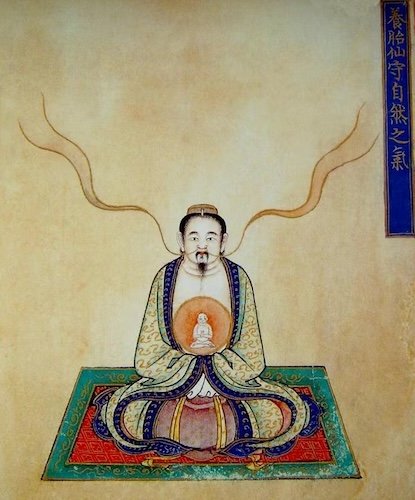
Some dandao lineages may instead use the term Dandao Cosmic Orbit to refer to what is also sometimes called the Macrocosmic Orbit, or Large Heavenly Orbit of neidan practice, in which pre-heaven Qi moves in the central channel (chong mai).
The opening of the Dandao Cosmic Orbit is an important milestone in the process of internal alchemy which paves the way for further development in dandao/neidan training. At more advanced levels a practitioner can form different elixirs (dan 丹), or move on to higher-levels of practice involving the Large Heavenly Orbit (macrocosmic orbit) and work on refining Qi into Shen. Gradually the practitioner progresses in the process of refining their Qi from a more coarse and turbit state to a more refined and pure state, with the culmination of the process being a body of Pure Yang Qi.

